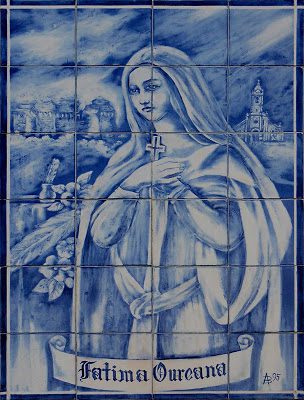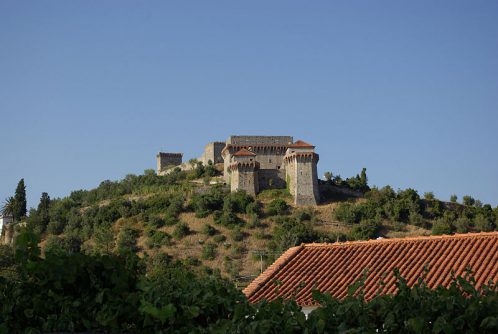How did this hamlet [Fatima] in a mountainous region of Portugal receive a name of evident Muslim origin?
What we know comes from a legend which, like all legends, has been embellished over the generations. However, many legends are based remotely on true history. The tale harkens back to the twelfth century when the Portuguese were fighting to liberate their territory from the Moorish invaders who had conquered the Iberian Peninsula in the eighth century.
This story was handed down from father to son over the centuries and written down by Fr. Bernardino de Brito in his Chronicle of the Order of Cister (1602). It recounts that a Moorish princess named Fatima lived in Portuguese lands. She was the daughter of a mighty emir.

Tiles depicting Princess Fátima Oureana, with the Castle on the left and the Shrine of Our Lady of Fatima on the right. Photo from ana-oliveira. blogspot.com
In 1158, a Portuguese knight named Gonçalo Hermingues, nicknamed “Traga-Mouros” (the Moor-Swallower) for his epic deeds against the Muslims, defeated her father in battle and took Princess Fatima as his prisoner. He then asked the Portuguese King, Dom Afonso Henriques, for permission to marry her. The king gave his consent on two conditions, that she freely convert to Catholicism, and that she agree to marry him.
At baptism, the princess received the name Oriana or Oureana. As a wedding gift, the king gave her a city which she named Oureana, after her new Christian name. Over time it became known as Ourém. Meanwhile, the mountainous lands nearby, where the princess lived for some time, became known by her original Muslim name: Fatima.(*)
(*) See Gentil Marques, Lendas de Portugal, Lendas dos nomes das terras (Lisbon: Âncora, 1962, 1999), 1:13–18; Wikipedia, s.v. “Fátima, Portugal,” ; Wikipedia, s.v. “Ourém.”
Luiz Sérgio Solimeo, Islam and the Suicide of the West: The Origin, Doctrine, and Goals of Islam (Spring Grove, Penn.: The American Society for the Defense of Tradition, Family, and Property, 2018), 187-8.
Short Stories on Honor, Chivalry, and the World of Nobility—no. 762












